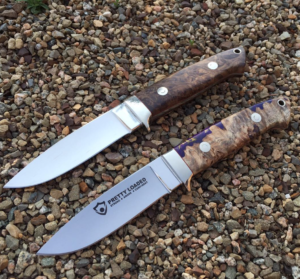Is CTS™-XHP the best steel? I think so.
CTS™-XHP steel at this time is my go to steel for Extra High-Performance knives. Frankly, I think it is incredibly hard to beat in performance. Carpenter’s XHP outperforms pretty much everything out there. It is a premium steel and it is coveted by knife makers around the world. I have been wanting to write a few articles about this steel for a while now.
That time is now. Let’s dive in!
Over the next few articles, I plan on covering the makeup of the steel, some in-depth explorations of the characteristics of the steel, and make some comparisons to other common steels you might encounter.
For this article, I am basically going to start to describe the metal to you if this is a little dry I apologize. The knife-geek inside me thinks this is awesome. The metallurgist inside me thinks this stuff is awesome. But I realize that my craft isn’t everyone’s hobby so stick with me.
General Description of CTS™-XHP: Straight from Carpenter
Carpenter CTS™ XHP alloy is powder metallurgy, air-hardening, high carbon, high chromium, corrosion-resistant alloy. It can be considered either a high hardness 440C stainless steel or a corrosion-resistant D2 tool steel.
CTS XHP alloy posses corrosion resistance equivalent to 440C stainless steel and can attain a maximum hardness of 64 HRC. In addition, the composition of CTS XHP alloy has been balanced so that it can attain a minimum hardness of 60 HRC when air cooled from hardening temperatures of 1850° to 2000° F (1010° C to 1093° C). CTS-XHP alloy is thus more forgiving during heat treatment than similar alloys.
Applications
Carpenter CTS XHP can be used for speciality knives where the alloy’s fine carbide distribution can be used to produce a keenly sharp cutting edge. The material can be easily ground to the thin profiles required for cutting tools. CTS XHP king blades can be finely polished to high luster or produced with a uniform matte finish.
Exciting! No?
Wow, I love this kind of stuff!
Let’s learn more, shall we?
First of all Carpenter’s XHP is an Alloy
Let’s just start out with the basics. An alloy is a metal that is mixed with other metals or elements. For clarity, an alloy is any chemical mixture of two elements, one of which is a metal. Go back to chemistry class because alloys can be a compound or a solid solution. The difference is that the two substances can sometimes be chemicals bonded or they can simply be physically intermixed. Most of the alloys we think of are the second kind. The atoms of the metal are simply intermixed with another metal or element.
Carpenter (and a bunch of other steel manufacturers) make several different alloys for specific purposes. For example:
- Superior Corrosion Resistant Alloys
- Medical Alloys
- Aerospace And High-Temperature Alloys
- Bearing Alloys
- Nickel-Copper Alloys
- High-Strength Alloys
- Gear Alloys
- Valve Alloys
- Magnetic, Controlled Expansion And Electronic Alloys
- Resistance Alloys
- Heating Element Alloys
- Thermocouple Alloys
- High-Nickel Alloys
- Borated Stainless Steels
- Tool And Die Steels
Pretty cool stuff really. This is deep metal science. When you make an alloy most people think of melting iron in a huge caldron and dumping in some carbon powder. Then stirring it with a large wooden paddle. Or something like that. If only it were that easy.
When you alloy metals there is something very important that you have to take into account. Phase change. The physical process of going from solid to liquid to solid again has some profound effects on a material. When you want to add other materials like zinc or chromium into the mix it becomes even more complex. To top it all off. You have to get a really fancy stir stick to keep the mix even through the entire batch. If you don’t you will have parts of the metal with different physical properties than in other parts of the metal. Basically, liquid alloying is kind of a pain in the rear.
…Enter Powder Metallurgy.
There are quite a few different techniques of powder metallurgy but the basic process is pretty similar. There are three basic steps: powder blending, die compaction, and sintering.
CTS™-XHP consists of carbon, silicon, nickel, vanadium, manganese, chromium, molybdenum, and of course… iron.
In powder blending, the mix of components can be completely uniform. Then the powder is filled into a die of some shape and compacted at room temperature. Sintering continues this process of compaction with a controlled atmosphere (sometimes it is advantageous to remove the oxygen). The result if sintering is a solid metal without ever melting the powder into a liquid.
The Incas of South America used this process on precious metals but the modern use of powder metallurgy didn’t start mass manufacturing until the late 1800s.
Beyond uniform mixing, there are three additional benefits of using powder metallurgy. One is that you can “play” with the chemistry of a metal to achieve very specific results. In other words, you can make alloys designed to do certain things. Secondly, the process of whole body melting of the base metal imposes unwelcome chemical, thermal, and internal stresses on the final product. These unfavorable conditions can be wholly avoided using powder metallurgy.
As a knife maker, the last benefit of creating an alloy using powder metallurgy is the most interesting. I am going to quote this one from good ol’ Wikipedia so take it for what it is worth.
All considerations of solid-liquid phase changes can be ignored, so powder processes are more flexible than casting, extrusion, or forging techniques.
The metallic properties are going to be more finely tuned than cast, forged, or extruded alloys.
This does not mean that CTS™-XHP isn’t heat treated. But it does mean that it doesn’t ever undergo a phase change from solid to liquid back to a solid. That’s really important to me.
I have knives to make. So… I am going to continue this in another post.
But before I go, I want to share with you how I handle most cuts in my shop. For the times when you cut yourself and a bandaid isn’t enough, I use 3M Steri-Strips. Click the Amazon link below to get the ones I use. they come in a nice 20 pack of 3 Steri-Strips that fit nicely in your wallet so you will always have them there when you need them. I hope you found this post informative and by clicking the Amazon link below it helps support MT Knives and make sure I can continue to bring you more post like this!
Thank you,
Patrick Roehrman


I never would have taken you for a metal head 😉